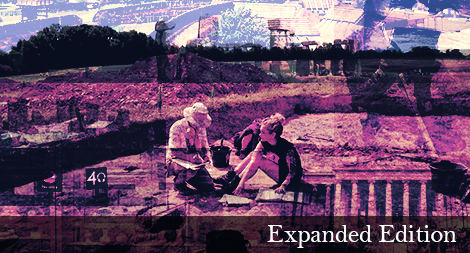Global Social Archaeology:expanded edition

Course Overview
The course is comprised of four parts, each divided into five 15 to 20 minute-long lectures.
Week 1 will introduce you to archaeology, what it is about, why it is fun, why we do it in the ways we do, and what meanings it has in contemporary society. We will also trace the history of archaeology by studying important archaeological theoretical and methodological packages that emerged at different times, though many of them currently co-exist. We will also learn about different archaeologies conducted in different parts of the world and consider as to why those different ways of doing archaeology have come into being.
Week 2 will introduce you to the world of Indigenous archaeologies. We will learn how the western world colonised other parts of the globe, where today’s Indigenous peoples live, and how that resulted in tremendous human sufferings and inequality which still continue in the present day. We will learn how this injustice has become recognised and what attempts have been made to amend it in archaeology. We will also learn how Indigenous peoples themselves are coming to terms with this negative legacy of human history through practicing archaeology in a way which is respects their traditional lifeways and their ancestors.
Week 3 will consider one of the core elements of social archaeology: moving back and forth between the past and the present, and, by drawing upon the outcomes of that practice, imagining a better future. We will study the two lives of gigantic Kofun tumuli of Japan. We will consider what meanings those monumental structures, their construction and repairment, and existence had to the people who were involved in their construction, who saw them, who at times enjoyed them, and who were charged to beautify them. By studying those episodes in the ‘life-course’ of these monuments, we will consider the relationships between the past, the present, and the future, which are constituted through our experience of the past.
Week 4 will introduce you to engaged archaeology, which engages with the social, cultural and political dimensions of the lives of the people with whom archaeologists work. We will also learn how we use and are helped by various material media to communicate and how the way we communicate and live our social lives is transformed, citing ancient and contemporary examples.
We will conclude the course with a conversation between myself and Professor Smith, which hopefully will inspire your imagination about how archaeology can be used for the creation of a better future.
Course Objectives
To learn the relevance of archaeology to the contemporary world by studying the nature and history of archaeology, the background of archaeological method and theory and various modes of archaeologies in the world. To consider how we can engage with contemporary society and how we can tackle its issues by doing archaeology.
Course Plan
Week1: What is Archaeology, and why?
Lesson1. What is archaeology?
Lesson2. How to approach to the past?
Lesson3. How have archaeologies been done? -History of Archaeology(1)
Lesson4. How have archaeologies been done? -History of Archaeology(2)
Lesson5. How are archaeologies being done? -Arcaheologies from different parts of the world
Week2: Indigenous Archaeology
Lesson1. What is Indigenous archaeology?
Lesson2. History of Indigenous archaeology
Lesson3. Indigenous knowledge systems(1)
Lesson4. Indigenous knowledge systems(2)
Lesson5. Indigenous knowledge systems(3)
Lesson6. Repatriation and indigenous cultural and intellectual property
Lesson7. The practice of indigenous archaeology
Week3: Moving back and forth between the past and the present: practicing social archaeology
Lesson1. What do we make sense of the Kofun tumuli?
Lesson2. The gigantic Kofun tumuli as imperial mausolea
Lesson3. De-constructing the Imperial Mausolea discourse(1)
Lesson4. De-constructing the Imperial Mausolea discourse(2)
Lesson5. Imagining different Kofun narratives
Week4: Archaeology today and future
Lesson1. Introduction to engaged archaeology
Lesson2. Engaged archaeology: The case study of Barunga
Lesson3. Making sense of social change in the past
Lesson4. Making sense of social change in the present and foreseeing the future
Lesson5. Conversation: what can archaeologies do in a contemporary society and for the world?
profile of Prof / Staff
| Koji Mizoguchi | |
|---|---|
 |
Hobbies: watching movies in movie theaters (no horror movies, please) Motto: "communication must go on" Education Level: Ph.D. (University of Cambridge, U.K., 1995) Specialty: Social archaeology, mortuary archaeology Books: Mizoguchi, K., 2013. The Archaeology of Japan: from the Earliest Rice Farming Villages to the Rise of the State. Cambridge University Press. Messages to students: We are what we learn from the past. Knowing and thinking about the past through archaeology will expand your horizon, empower you, and enable you to create a better future. |
| Claire Smith | |
|---|---|
 |
Hobbies: reading female detective novels. Motto: the motto of my High School “all things to the best of my ability” - Omnia Sedulo Final degree: PhD in archaeology, University of New England, 1996 Specialty: Indigenous, archaeology, rock art, gender, global archaeology Books: Smith, C. (ed.) 2014. Encyclopedia of Global Archaeology. New York: Springer. Messages to students: “Work hard and enjoy” “Ask us if you do not understand something” “Follow your passion, as that is the best route to high achievement" |
| Ari Tanizawa | |
|---|---|
 |
Affiliation: Assistant Professor, Innovation Center for Educational Resource, Kyushu University Theme: Archaeology. State formation and material culture. |
Premise-type Knowledge
None. Just interested in the past and the present qualifies you to take this course.
EXAMS
1. Weekly multiple-choice questions for confirming tests.
2. multiple-choice questions for the final test.
The due for the weekly tests and the final exam: February 16, 2016.
Issued date of the certificate: February 22, 2016.
Completion requirements
・Taking the three Weekly tests, and the final exam.
・Achieving 60 points or above from the weekly tests and the final exam.
Reference
Archaeology: the basics (2nd Edition)' by Clive Gamble (Routledge, 2007)


